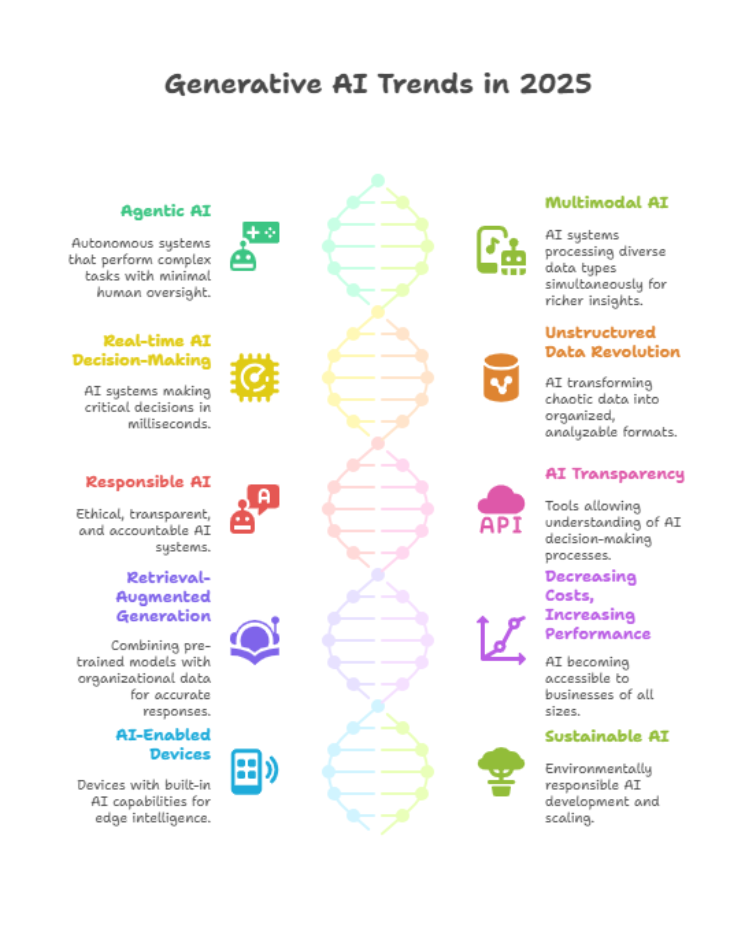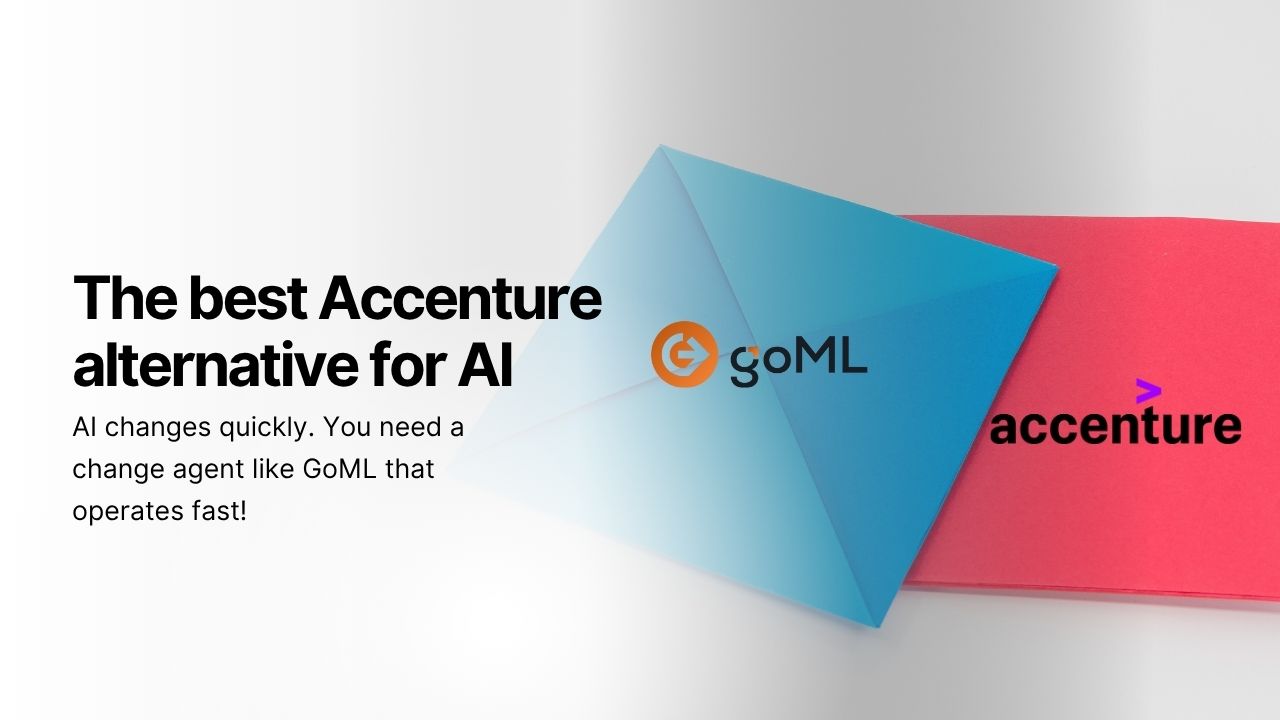Welcome to the future; it's arriving faster than you think.
If 2024 was the year AI went mainstream, then 2025 is when it truly transforms how we live, work, and innovate. With global AI investments surging toward $200 billion and the market size expected to reach $243.72 billion this year alone, we're witnessing an unprecedented acceleration in artificial intelligence capabilities.
From autonomous agents that work like digital employees to multimodal systems that think with all their senses, the generative AI landscape is evolving at breakneck speed.
Here are the top 10 trends that are reshaping the world of generative AI trends in 2025, and why they matter more than ever before.
1. Agentic AI: your new digital workforce
The days of simple chatbots are over. Enter agentic AI, autonomous systems that don't just answer questions but actually get things done. These digital agents can tackle complex tasks independently by creating workflows, using tools, and making decisions with minimal human oversight.
Real impact: Microsoft's sales teams using Copilot agents have already boosted revenue by 9.4% per seller and closed 20% more deals. As Sam Altman, CEO of OpenAI, puts it, "This is the idea that you can give an AI system a pretty complicated task, the kind of task you'd give to a very smart human, that takes a while to go off and do and use a bunch of tools and create something of value."
What it means: Marketing teams can deploy AI agents to track campaigns, doctors can use them for patient monitoring, and businesses can automate complex workflows without constant supervision.
2. Multimodal AI: thinking with all the senses
Generative AI trends in 2025 mark the rise of AI systems that can process text, images, audio, and video simultaneously, just like humans use all their senses to understand the world. This isn't just about handling different file types; it's about creating richer, more accurate insights by combining diverse data sources.
Real impact: In retail environments, multimodal AI can analyze sales data, shelf images, and customer behavior videos simultaneously to optimize product placement strategies in real time.
What it means: More holistic decision-making, enhanced accessibility across different formats, and AI that truly understands context the way humans do.
3. Real-time AI decision-making: millisecond intelligence
AI systems now process millions of data points and make critical decisions in milliseconds, fundamentally changing how businesses operate. This isn't about faster computers; it's about AI that thinks and acts at the speed of business.
Real impact: PayPal's AI-driven fraud detection system handled 6.5 billion transactions in Q1 2024 alone, while platforms like Quantcast analyze data from over 100 million online destinations for instant advertising decisions. Similarly, GoML reduced data turnaround time by 85% for a hedge fund, demonstrating how real-time AI can transform financial decision-making.
What it means: Instant fraud detection, real-time personalized customer experiences, automated risk assessment, dynamic pricing, and immediate threat detection in cybersecurity.
4. Unstructured data revolution: chaos becomes clarity
One of generative AI's most surprising strengths is transforming chaotic, unstructured data, images, audio, text, videos, into organized, analyzable formats. Through advanced vectorization techniques, previously unusable data sources are becoming goldmines of insight.
Real impact: Organizations can now extract valuable insights from emails, social media posts, audio recordings, and images that were previously impossible to analyze systematically through generative AI applications.
What it means: Better predictions, enhanced machine learning models, improved fraud detection, and data-driven decisions from sources that were once considered "digital noise."
5. Responsible AI: building trust at scale
As AI becomes more powerful, the focus on ethical, transparent, and accountable systems intensifies. Organizations are no longer treating AI governance as an afterthought; it's becoming central to development strategies.
Real impact: UNESCO has issued global standards on AI ethics, and companies are investing in governance infrastructure alongside technical development to ensure responsible AI deployment.
What it means: Fair, transparent, and human-centric AI systems that build trust with users and create sustainable foundations for long-term AI adoption.
6. AI transparency: opening the black box
The era of mysterious AI decision-making is ending. Tools like LangChain are allowing us to understand how AI systems reach their conclusions, moving from "black box" operations to transparent, accountable processes.
Real impact: In healthcare and finance, where accuracy is paramount, reasoning tools help professionals understand and verify AI-generated recommendations.
What it means: More reliable AI systems, increased accountability in critical decisions, and greater confidence in AI-powered solutions across sensitive industries.
7. Retrieval-augmented generation (RAG): smart AI without the training overhead
Instead of fine-tuning models or building from scratch, RAG combines pre-trained models with organizational data to generate accurate, contextually relevant responses without massive resource investments.
Real impact: Companies can deploy sophisticated AI solutions using their existing data without needing specialized datasets or extensive model training through LLM-powered applications.
What it means: Faster AI implementation, reduced costs, immediate access to historical data, and more accurate responses tailored to specific organizational needs.
"In 2025, generative AI is moving beyond prototypes into production, with Retrieval-Augmented Generation (RAG) and LLMs enabling smarter, faster, and more context-aware decisions. At GoML, we're engineering AI systems that combine the power of foundation models with domain-specific knowledge, delivering real business impact while keeping transparency, governance, and scale at the core."
— Prashanna Rao, Head of Engineering, GoML
8. Decreasing costs, increasing performance: AI for everyone
Token costs are plummeting while performance soars, making advanced AI accessible to businesses of all sizes. Hardware innovations and efficient multi-tenancy models are driving down operational costs dramatically.
Real impact: Small businesses can now afford to implement AI solutions that were previously exclusive to tech giants, democratizing access to advanced automation and intelligence. The key consideration for organizations is whether to build vs buy generative AI solutions, with many finding that strategic partnerships accelerate implementation.
What it means: More embedded AI in daily operations, increased automation across industries, and AI-powered productivity gains without prohibitive costs.
9. AI-enabled devices: intelligence at the edge
By 2025, over 30% of smartphone shipments will include built-in AI capabilities, while 50% of laptops will feature local AI processing. This represents a fundamental shift from cloud-dependent AI to edge intelligence.
Real impact: Devices that automatically manage energy consumption, predict equipment failures, enhance security with AI-powered cameras, and create personalized experiences while protecting privacy.
What it means: Faster AI responses, enhanced privacy through local processing, reduced dependence on internet connectivity, and smarter device ecosystems that work seamlessly together.
10. Sustainable AI: green intelligence for the future
As AI's environmental footprint grows, the industry is pivoting toward sustainability. With generative AI potentially generating 47 million tons of carbon dioxide annually if adopted globally, the focus on energy-efficient solutions is becoming critical.
Real impact: Companies are developing low-energy AI models, optimizing data center cooling, and implementing techniques like prompt engineering to reduce resource consumption.
What it means: Environmentally responsible AI development, reduced operational costs, sustainable scaling of AI infrastructure, and long-term viability of AI adoption across industries.

Watch emerging generative AI trends
This is the year generative AI trends became products, solutions, and workflows for millions of enterprise users. 2025 is when generative AI evolved from an impressive tool to an indispensable partner.
At GoML, we understand that navigating this AI transformation can be overwhelming.
Our comprehensive generative AI consulting and development services span across all the trends mentioned in this blog, from implementing agentic AI systems and multimodal solutions to developing real-time decision-making platforms and sustainable AI architectures.
Whether you need help with RAG implementations, AI transparency tools, or responsible AI governance frameworks, our expert team transforms these trends into practical business solutions that deliver measurable results cheaper than traditional approaches.
Ready to harness these game-changing generative AI trends for your business?
Navigate agentic AI, multimodal systems, and real-time decision-making with expert guidance. Partner with an AI development company that transforms these revolutionary trends into measurable ROI across your critical processes.
Connect with GoML today and turn cutting-edge generative AI trends into competitive advantages.





